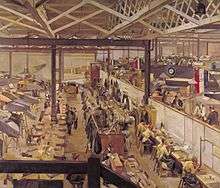Anna Airy
| Anna Airy | |
|---|---|
 | |
| Born |
6 June 1882 Greenwich, London, England |
| Died |
23 October 1964 (aged 82) Greenwich, London, England |
| Nationality | British |
| Known for | Painting, Pastel, Etching |
Anna Airy (6 June 1882 – 23 October 1964) was an English oil painter, pastel artist and etcher. She was one of the first women officially commissioned as a war artist[1] and was recognised as one of the leading women artists of her generation.[2]
Early life
Airy was born in Greenwich, London, the daughter of an engineer, Wilfrid Airy, and Anna née Listing, and the granddaughter of the Astronomer Royal George Biddell Airy.[3][4] Airy trained at the Slade School of Fine Art in London from 1899 to 1903, where she studied alongside William Orpen and Augustus John, and under Fred Brown, Henry Tonks and Philip Wilson Steer. Airy won prizes at the Slade School for portrait, figure, and other subjects including the Slade School Scholarship in 1902. She also won the Melville Nettleship Prize in 1900, 1901 and 1902.[5][6]
Work

During World War I, Airy was given commissions in a number of factories and painted her canvases on site in often difficult and, sometimes, dangerous conditions.[1] For example, while working at great speed to paint A Shell Forge at a National Projectile Factory, Hackney Marshes, London in an extremely hot environment, "the ground became so hot that her shoes were burnt off her feet".[7] This painting was featured in an exhibition at the Imperial War Museum's 2011–2012 exhibition Women War Artists.[8]
In June 1918 the Munitions Committee of the Imperial War Museum, IWM. commissioned her to create four paintings representing typical scenes in four munitions factories:[9] These included,
- National Projectile Factory at Hackney;[7]
- National Filling Factory at Chilwell, Nottingham, W G Armstrong Whitworth's at Nottingham;
- Aircraft Manufacturing Co. at Hendon;[10]
- South Metropolitan Gas Co.
The Chilwell commission was replaced by a request for a painting of work at the Singer factory in Glasgow.[11] Airy was also commissioned by the Women's Work Section of the IWM during the war. In 1917 she was commissioned by the Canadian War Memorials Fund; and in 1940 by the Ministry of Munitions.[5]
Airy was married to the artist Geoffrey Buckingham Pocock and for many years the couple lived at Haverstock Hill in Hampstead before moving to Playford near Ipswich.[6]
Exhibitions
Airy's work was exhibited at the Royal Academy in 1905 and in each subsequent year there until 1956, her first one-woman exhibition having been held at the Carfax Gallery in 1908. Airy also exhibited at exhibitions at the Paris Salon and in Italy, Canada and in the United States. She has been represented in the British Museum; the Victoria and Albert Museum; and the Imperial War Museum. Her work also appeared in the Art Gallery of New South Wales, Sydney as well as in Auckland, New Zealand; Vancouver and Ottawa in Canada; and in the Corporation Art Galleries of Liverpool, Leeds, Huddersfield, Birkenhead, Blackpool, Rochdale, Ipswich, Doncaster, Lincoln, Harrogate, Paisley and Newport.[5] Her etching Forerunners of Fruit (c.1925) is in the collection of the Art Gallery of New South Wales.[12]
Publications
Airy is the author of:
Memberships
Airy was a member of several artistic societies.[15] She was elected as a member of The Pastel Society in 1906. She also joined the Royal Society of Painters and Etchers in 1908 when the society elected her. She was also an elected member of the Royal Institute of Oil Painters (1909), Royal Institute of Painters in Water Colours (1918), and Member of the Royal Glasgow Institute of the Fine Arts (1952). She was elected as the President of the Ipswich Art Society in 1945.[14]
References
- 1 2 Arifa Akbar (8 April 2011). "Women at war: The female British artists who were written out of history". The Independent. Retrieved 2 September 2013.
- ↑ Tolson, Roger. "Art and Daily Life in World War Two". BBC History. Retrieved 16 June 2012.
- ↑ Goward, K. J. (2006). "Founding of Orwell Park Observatory". Institute of Astronomy. Archived from the original on 15 November 2007. Retrieved 16 December 2007.
- ↑ Biography from Thompson's Galleries, London Archived 19 July 2012 at the Wayback Machine.
- 1 2 3 Who Was Who, 'AIRY, Anna' A & C Black, 1920–2008 (online edn ed.). Oxford University Press. December 2007. Retrieved 16 June 2012.
- 1 2 Richard Green (1995). Modern British Paintings (Exhibition Catalogue). Richard Green Gallery.
- 1 2 Imperial War Museum. "A Shell Forge at a National Projectile Factory, Hackney Marshes, London, 1918 [Art.IWM ART 4032]". IWM Collections Search. Retrieved 17 April 2013.
- ↑ Imperial War Museum (7 April 2011). "Press Desk: Women War Artists". archive.iwm.org.uk. Retrieved 17 April 2013.
- ↑ Imperial War Museum. "Miss Anna Airy [ART/WA1/031 (First World War Art Archive)]". Retrieved 17 April 2013.
- ↑ Imperial War Museum. "An Aircraft Assembly Shop, Hendon [Art.IWM ART 1931]". IWM Collections Search. Retrieved 17 April 2013.
- ↑ Amanda Mason. "6 Stunning First World War Artworks by Women War Artists". Imperial War Museum. Retrieved 1 April 2017.
- ↑ AGNSW collection record
- ↑ "Airy, Anna." Chambers Biographical Dictionary. London: Chambers Harrap, 2007. Credo Reference. Web. 25 March 2010
- 1 2 Frances Spalding (1990). 20th Century Painters and Sculptors. Antique Collectors' Club. ISBN 1 85149 106 6.
- ↑ Sara Gray (2009). The Dictionary of British Women Artists. The Lutterworth Press. ISBN 97807 18830847.
External links
| Wikimedia Commons has media related to Anna Airy. |
- 20 paintings by or after Anna Airy at the Art UK site